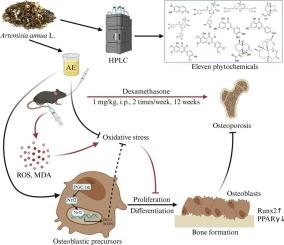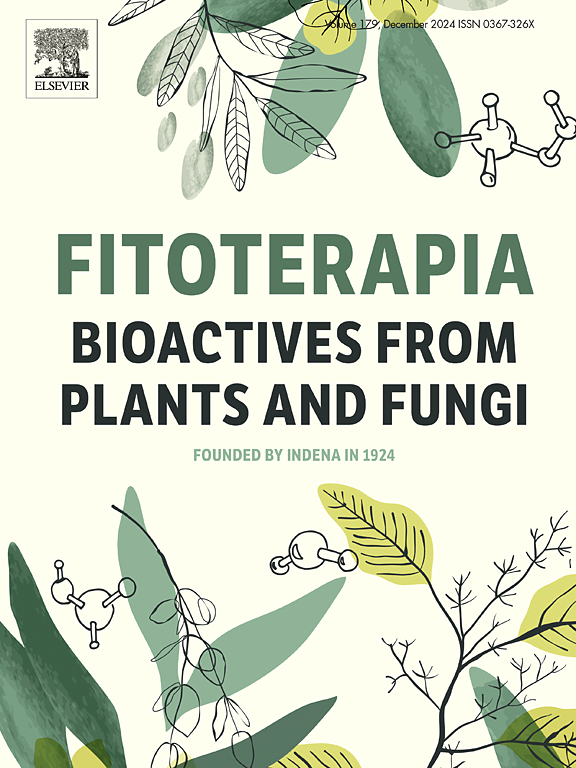黄花蒿提取物通过PGC-1α/Nrf2/HO-1/SOD2通路刺激骨形成,减轻糖皮质激素所致骨质疏松。
IF 2.6
3区 医学
Q3 CHEMISTRY, MEDICINAL
引用次数: 0
摘要
氧化应激(OS)抑制骨形成并促进糖皮质激素诱导的骨质疏松症(GIOP)的骨质流失。黄花蒿(Artemisia annua L., AA)是一种传统上用于治疗骨蒸和骨科疾病的氧化性中药,已显示出抗骨质疏松剂的潜力。本研究采用地塞米松(Dex)诱导的GIOP小鼠注射AA提取物(AE),观察其抗骨质疏松作用。AE能有效改善GIOP小鼠的骨质流失,刺激骨形成,减轻氧化损伤。在MC3T3-E1成骨细胞中,AE恢复了dex损伤的增殖和成骨分化。AE还能抑制ROS和MDA的积累,促进CAT和SOD的活性,上调PGC-1α、Nrf2、HO-1和SOD2的表达。sirna介导的PGC-1α或Nrf2的敲低抵消了AE对这些抗氧化基因的调节作用,并伴随着转染细胞中氧化损伤的增加。虚拟药代动力学预测、真实药代动力学数据和报道的药理作用的综合分析表明,木犀草素是AE抗氧化和抗骨质疏松活性的主要贡献者。综上所述,AE通过PGC-1α/Nrf2/HO-1/SOD2通路改善dex损伤的成骨细胞分化,从而促进骨形成,提示其可能作为GIOP和其他os相关骨科疾病的治疗剂。本文章由计算机程序翻译,如有差异,请以英文原文为准。

Artemisia annua L. extract alleviates glucocorticoid-induced osteoporosis by stimulating bone formation via PGC-1α/Nrf2/HO-1/SOD2 pathway
Oxidative stress (OS) inhibits bone formation and contributes to bone loss in glucocorticoid-induced osteoporosis (GIOP). Artemisia annua L. (AA), an oxidative Chinese medicinal herb traditionally used to treat bone steaming and orthopedic diseases, has shown potential as an anti-osteoporotic agent. In this study, AA extract (AE) was administered to dexamethasone (Dex)-induced GIOP mice to investigate its anti-osteoporotic activity. AE effectively ameliorated bone loss, stimulated bone formation, and mitigated oxidative damage in GIOP mice. In MC3T3-E1 osteoblastic cells, AE rescued the Dex-impaired proliferation and osteogenic differentiation. AE also inhibited the accumulation of ROS and MDA, promoted the activity of CAT and SOD, and upregulated the expression of PGC-1α, Nrf2, HO-1, and SOD2. siRNA-mediated knockdown of PGC-1α or Nrf2 counteracted AE's regulatory effects on these antioxidant genes, concomitant with increased oxidative damage in transfected cells. An integrated analysis of virtual pharmacokinetic predictions, authentic pharmacokinetic data, and reported pharmacological effects suggested that luteolin was the principal contributor to the antioxidant and anti-osteoporotic activities of AE. In summary, AE promotes bone formation by improving Dex-injured osteoblast differentiation via the PGC-1α/Nrf2/HO-1/SOD2 pathway, indicating its potential as a therapeutic agent for GIOP and other OS-related orthopedic diseases.
求助全文
通过发布文献求助,成功后即可免费获取论文全文。
去求助
来源期刊

Fitoterapia
医学-药学
CiteScore
5.80
自引率
2.90%
发文量
198
审稿时长
1.5 months
期刊介绍:
Fitoterapia is a Journal dedicated to medicinal plants and to bioactive natural products of plant origin. It publishes original contributions in seven major areas:
1. Characterization of active ingredients of medicinal plants
2. Development of standardization method for bioactive plant extracts and natural products
3. Identification of bioactivity in plant extracts
4. Identification of targets and mechanism of activity of plant extracts
5. Production and genomic characterization of medicinal plants biomass
6. Chemistry and biochemistry of bioactive natural products of plant origin
7. Critical reviews of the historical, clinical and legal status of medicinal plants, and accounts on topical issues.
 求助内容:
求助内容: 应助结果提醒方式:
应助结果提醒方式:


